If there’s one thing that the Panama Canal has going for it, it’s the fact that it’s a pretty unique tourist destination. As one of the Seven Wonders of the Modern World, it’s an absolute must-see for anyone visiting the country. You won’t find anything else quite like it anywhere else in the world, and that’s part of what makes it so special.
If you’ve ever wanted to see this amazing attraction, here’s our guide to how to visit the Panama Canal, including the best places to view the ships and what to expect.
Where can you watch ships pass through the locks?
The best place to watch ships pass through the locks is at the Miraflores Locks Visitors Center in Panama City. On the Atlantic end of the Canal, Agua Clara Locks offers two covered viewing platforms, from which you can observe ships in two sets of locks (Agua Clara and Gatun).
Where can you visit the Panama Canal for free?
The Panama Canal is 48 miles long and cuts straight through the Republic of Panama. Clearly, this means that there are plenty of great areas where you can see the water and spot ships passing through it.
One of the easiest places to see the Panama Canal is on the road going to Soberania National Park and Gamboa Rainforest Reserve. In some places, the road runs right next to the Panama Canal. It’s easy to pull off the road and watch the ships pass by.
Another of our favorite places is at the western end of Bridge of the Americas. Here, you’ll get a good sense of how huge the Panama Canal really is. There’s a small parking lot where you’ll find a few vendors as well as a monument from China, erected to honor the many Chinese who labored to build the canal. This spot offers a bird’s-eye view of all the ships as they enter and leave the Panama Canal. You can also see the loading docks for the canal train.
As far as we know, no buses stop here. You’ll have to drive or take an Uber/taxi to the “Chinese Monument.” There is no admission fee.
How many locks does the Panama Canal have?
Here’s a list of locks, from the Pacific to the Atlantic side:
- Miraflores Locks – the most visited because it’s closest to Panama City and has a beautiful visitor center.
- Pedro Miguel Locks – a single set of locks a few minutes north of Miraflores. This is the least impressive spot and is not set up for visitors.
- Cocoli Locks – Three larger locks were built as part of the expansion, adjacent to Pedro Miguel Locks. No visitor facilities.
- Gatun Locks – the three locks that are on the Atlantic (Caribbean) side of the canal. They lie near the city of Colón, an hour’s drive from Panama City.
- Agua Clara Locks – the newest locks, near Gatun Locks, built to handle Panamax ships. They also have a visitor center, which you can read about here.
What’s the best way to see the Panama Canal?
The easiest way to see the Panama Canal is to drive there yourself. It’s a 15-minute drive to Miraflores Visitor Center from downtown Panama City, and the route is straightforward. Agua Clara Locks are 1 hour away by car, near Colon City on the Atlantic side. You can easily visit both in one day.
We have an article about driving in Panama, and you can check car rental prices here.
If you’d rather not drive through an unfamiliar city, a guided tour is the next best option. Tours come in all shapes, sizes, and prices, and some include more than one stop.
If at all possible, make sure your tour includes a boat trip to Monkey Island. It’s amusing to see the monkeys up close, and maybe even feed them!
Why does the Panama Canal need locks?
If Panama were flat, it wouldn’t need locks, but the mountains in the center of the country are high enough that blasting through them would be impractical. The alternative was to lift the ships up and over the Continental Divide.
In the early 1900s, they dammed the Chagres River near Colón and created two lakes: Miraflores (near the Pacific) and Gatun (near the Caribbean). That was the easy part. They had to deal with 12.6 kilometers (7.8 mi) of mountains between them.
Plus, there was a lot of dense jungle to deal with, laden with disease-carrying mosquitos and dangerous wildlife.
Long story short, the French gave up due to the difficulty, cost, and immense loss of life. The U.S. took over in 1904 and finally blasted, dredged, and dug a channel between the two lakes that would be wide enough to accommodate container ships.
This hard-to-navigate channel came to be known as the Culebra Cut, and its creation is an incredibly dramatic story.
ⓘ TIP: For the story behind this engineering marvel, read The Path Between the Seas, by David McCullough. It’s the story of how the Panama Canal was built and is a great read for anyone interested in American history, technology, or international intrigue.
Want to read this later? Pin it to Pinterest!
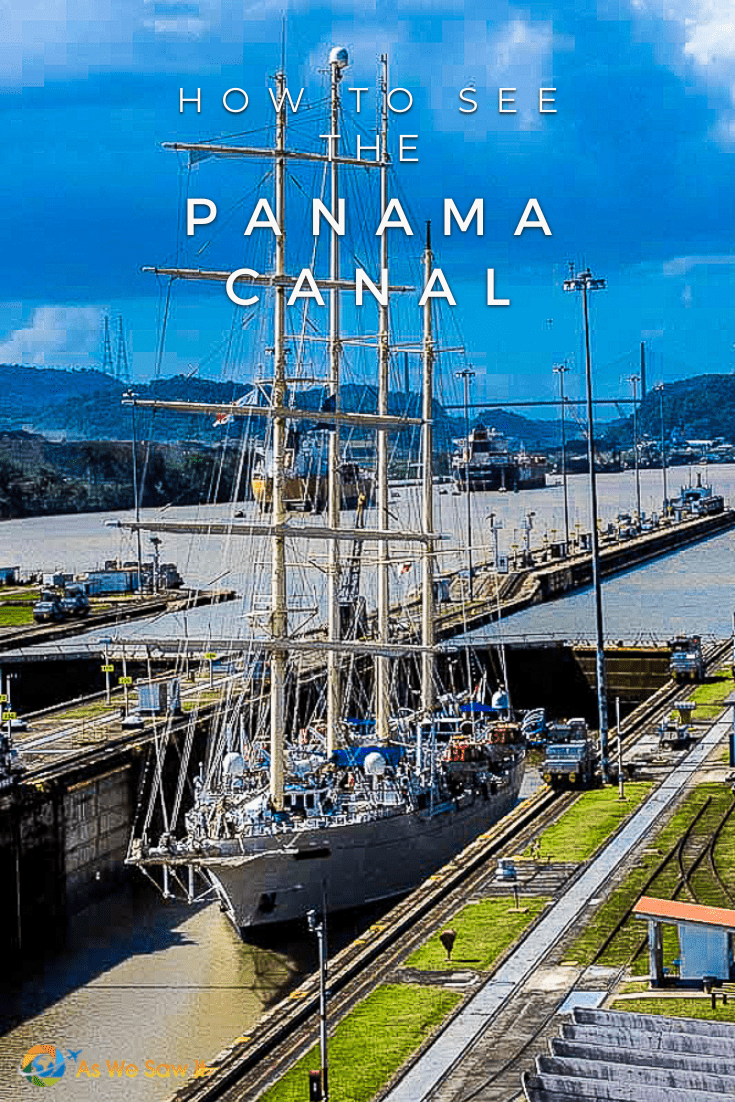
How the Panama Canal is laid out

- Beginning at the Pacific, a series of two locks raise ships up to the water level of Miraflores Lake.
- Ships then continue to the other end of Miraflores Lake, where a single lock at Pedro Miguel lifts the ships even higher.
- Ships navigate the treacherous Culebra Cut to Gatun Lake.
- Once they pass through Gatun Lake, a triple flight of locks at Gatun lowers them to the level of the Caribbean Sea, and they leave the canal.
Understanding how the canal operates

I could have a ho-hum, been-there-done-that attitude, but I always enjoy visiting. The Canal has an announcer who narrates details about the current ship that’s passing through – its nationality, size, cargo, and other particulars – and explains how the canal system operates. He/she does it little by little, moving back and forth between Spanish and English. It’s fun to try to understand the Spanish words.
Some of these ships are so wide that only a few inches separate them from the concrete sides of the locks. Others are small enough that more than one can fit at a time. In either case, it’s vitally important to protect the locks from accidental damage, so pleasure boats and small fishing boats usually transit next to a canal tugboat and they just get tied to the tugboat as they go.
A lockmaster on each side of the locks has ready communication with both the pilot and the control tower for the entire operation.
Canal limitations

When the Panama Canal opened in 1914, canal authorities set up a set of guidelines for the maximum size that would be allowed to enter and termed it “Panamax.” The size includes the width and length of the available lock chambers, the depth of water in the canal, and the height of the bridges that span the canal. The third set of locks, which opened in June of 2016, allows even larger, “New Panamax” ships.
Though its two “lanes” of canals make it look like the ships might be able to go in both directions at the same time, the Culebra Cut makes this impossible. This treacherous area is far too narrow for large ships to pass each other. (This area was the biggest challenge when they built the canal: They had to blast and cut their way through.) So, for 12 hours a day, ships pass from north to south, and for the other 12, they go from south to north.
The original canal has two lanes, each with its own set of locks. The expansion project added a third lane through the construction of lock complexes at each end of the canal. One lock complex is located on the Pacific side, southwest of the existing Miraflores Locks. The other is located east of the existing Gatun Locks. Each of these new lock complexes has three consecutive chambers designed to move vessels from sea level to the level of Gatun Lake and back down again.
Avoiding accidents in the canal

Yes, you heard me right. I said pilot. The ship’s captain is required to yield control of the ship while it’s transiting. The Panama Canal has people who are specially trained to guide ships through safely, mainly because of the Culebra Cut. It is so narrow that only one ship can go through at a time.
What if a ship’s captain, who is used to navigating the open seas, misjudged and ran aground in the canal? Imagine the havoc that would happen – not to mention how it would affect world trade! Fortunately, the pilot gives him a break.
Small towing locomotives, called mules, will use cables to safely guide the larger ships through. Up to eight towing locomotives and sixteen cables will guide them through the canal. Line handlers are trained to be accurate in getting those wires on board the ship as fast as possible to provide a safe transit.
Visiting Miraflores Visitor Center

Make time to visit the Miraflores Visitor Center, a fascinating place that will help you understand how the entire canal operates. They have informative films, an interesting museum that even kids will enjoy (fish! bugs!) plus viewing platforms where you can watch the ships pass through.
Film showings alternate between Spanish and English, so ask when the next English showing is and plan your schedule around that. If you have any questions, all the staff are bilingual and incredibly helpful and informative.
I still enjoy watching the enormous ships rise skyward as the locks fill with lake water and the 7-foot-thick gates open and close. Sometimes while they wait, the ships’ crews and passengers will wave to everyone, and the platform full of people will wave back. It’s a bit too far away for the crew to hear anyone shout “Hola!” or “Bienvenidos!” (welcome) – assuming that they’d understand the words – but a smile and a wave will always express what words can’t.

Inside Miraflores Visitor Center
Your ticket allows access to more than just the viewing platform: The Visitor Center also features:
- an ample, fully equipped theater
- the observation terraces
- two snack bars
- a white tablecloth-type restaurant with a panoramic view, and
- the ubiquitous gift shop.
The products they sell at the gift shop are unique and you won’t find them anywhere else. I’ll confess that even though we rarely buy souvenirs, I once succumbed to its lure. I bought a cool ceramic tea mug with a historic map of the Panama Canal on its side. It came complete with a lid and a basket that holds the tea leaves as they steep.
But I digress.
The Panama Canal History Museum

Even if you’re not normally a history buff, there’s a lot of cool stuff in the museum. The museum has historic pieces, models of ships and construction equipment, a navigation simulator, video presentations, a topographical model of the Panama Canal itself, and objects used in Canal operations.
Here’s how the four-level Panama Canal Museum is laid out, floor-by-floor.
- The History Hall portrays the background, technological innovations, and sanitary initiatives during the construction of the Canal.
- The Hall of Water: Source of Life – the importance of water, environmental conservation and biodiversity, and protecting the Canal Watershed.
- The Canal in Action – how the Canal operates, Canal improvement, modernization, and maintenance projects. You can also experience being inside one of the lock culverts and pretend you’re piloting a ship through a lock.
- The Canal in the World – the importance of the Canal to world trade, the trade routes it serves, its main users, the various types of vessels that what go through, and what they carry.
Visit Gatun Locks on the Atlantic side
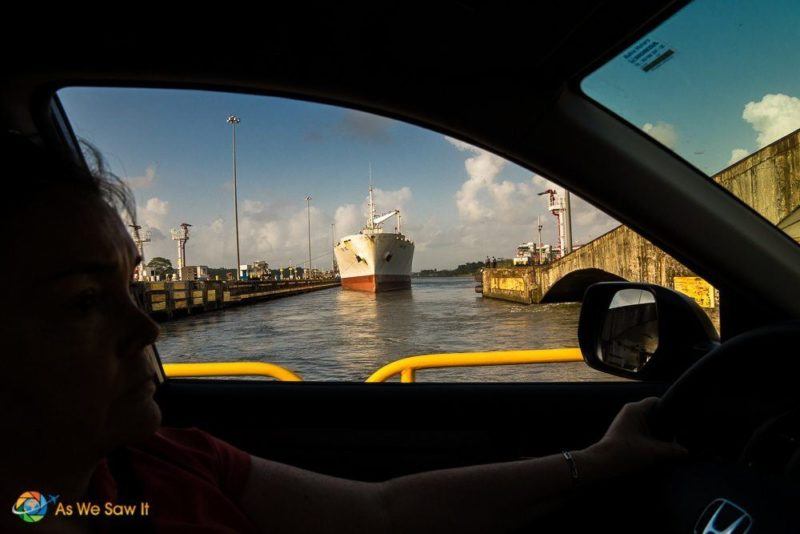
If we have the time, we like to take our visitors to see both ends of the canal: Gatun and Miraflores. The canal locks at Gatun aren’t very crowded, whereas Miraflores can be wall-to-wall people. Besides, what you lose from not having a Panama Canal museum to visit, you gain from being practically an arm’s reach away from the ships.
There is a small viewing platform and live play-by-play descriptions of each ship that passes through, in both Spanish and English. If you have any questions, ask away. All visitor center employees here are bilingual, and everyone is extremely helpful.
Unless you love ships, you will probably be satisfied after watching one or two ships pass through, just as our visitors are. But considering the hour-long drive to get here, we have a couple of ways to extend our trip, both of which are on the other side of the canal.
- a drive to Fort San Lorenzo, a UNESCO site that’s perfect for views, history and nearby beaches
- a chance to visit Agua Clara Locks
Here’s where the fun comes in: To get there, you can drive through the Panama Canal!
I have no idea how they came up with the idea, but yes, there is actually a roadway over the canal, at water level. We exit the parking lot and turn left, stopping at a traffic signal. It seems a bit odd to see a stoplight here.
Once the massive metal gates at Gatun Locks have closed and begun to fill with water, a one-lane metal bridge rotates to create a roadway over the canal. Soon the light turns green, a guard waves us through and we descend the ramp to the bridge. The Caribbean is only a few feet beneath our tires.
The massive doors tower overhead as our car slowly crosses the narrow bridge, so close we might count every rivet. Rivulets of water drip and spew from cracks and crevices around the doors, reminding us that a wall of water lies just beyond. Please stay closed, our minds plead, and we avert our gazes in the other direction, even though we know there’s no risk at all.
There, we see a ship awaiting its turn. Yikes! It looks monstrous from down here!
Once on the other side of the canal, the drive to San Lorenzo is picturesque, with alternating views of the azure sea and dense rainforest. It is worth the time, but that’s a story for another day. Today, until they build that long-promised Atlantic Bridge, there’s no other route back home. We’ll be driving over the canal again later.
Tip: You’re not allowed to stop while you drive over the Panama Canal. So switch drivers before you drive back. Everyone deserves a chance to get this view!
Agua Clara locks and visitor center
The Panama Canal Expansion was the largest project since the canal was built. Thanks to the new lane of traffic and larger locks, it is wide enough for even the mega-sized New Panamax ships to pass through.
To understand more about it, you’ll want to visit the nearby Agua Clara Visitor Center. We don’t have any first-hand knowledge because it opened after we left Panama, but what kind of article would this be if we didn’t share what we do know?
The Agua Clara Visitor Center offers a panoramic view of the recently opened expansion from a viewpoint 50 meters above the canal. Depending on which way you turn, you will enjoy fabulous views of the new Agua Clara Locks or Gatun Lake.
Additionally, the Visitor Center offers a chance to learn how the newly expanded Panama Canal works, as well as discover Panama’s wildlife on an ecological trail through a tropical rainforest. Amenities include a restaurant overlooking Gatun Lake, a cafeteria, a children’s playground, and a gift shop.
ⓘ PRO TIP: There is no ticket office at the Agua Clara Visitor Center. Purchase tickets at the Gatun Locks ticket office.
Plan your visit to the Panama Canal
Here is some helpful information to help you plan your trip to Panama.
Panama Canal visiting hours and fees
- Miraflores Visitor Center admission is B/.15.00 (B/.10.00 for children between 6 and 12). (Balboas are currently equivalent in value to USD.) Hours: open daily 9-4:30.
- Expect to pay B/.5.00 to visit Gatun Locks (free for anyone under 12). Hours: open daily from 8:00-4:00, including holidays.
- Agua Clara Visitor Center admission is B./.15. Hours: open daily 8:00-3:15pm.
- Avoid visiting Miraflores at midday (between about 10:30am-2pm). You won’t see any ships in the locks during that time. This is when the canal changes directions, and it takes that long for ships to clear the canal.
For additional information on the Panama Canal or to make a reservation at Miraflores’ full-service restaurant, call +507 276-8325 or -8449. You can also email [email protected].
Practical tips
- Dress in layers. It can be hot outside on the platforms and cool inside. (Platforms are sheltered from the rain and sun.)
- It can get windy outside. If you have long hair, you may want to bring a comb or tie it back.
- If you want to eat at the restaurant at Miraflores, it’s best to call ahead so you can request a table with a view. You can dine in air-conditioned comfort indoors or choose to dine al fresco. Just be aware that it can be breezy, so you may want to carry a light jacket.
How to get to Miraflores Visitor Center
- MetroBus has a route that goes directly to Miraflores from Albrook Station. Cost: 25¢ each way.
- It’s also easy to get to the Visitor Center with Uber or taxi. Expect to pay $10-15 each way.
- You can also book a tour. This one is especially popular.

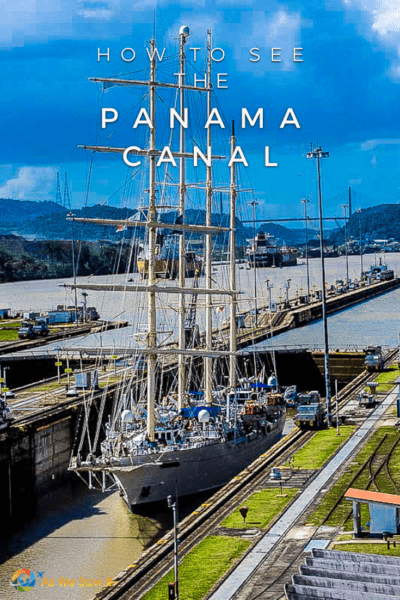
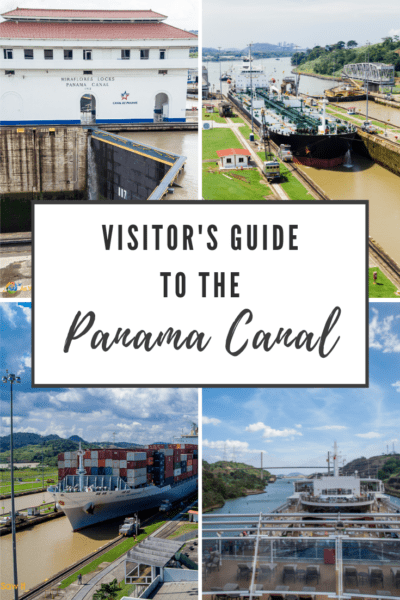
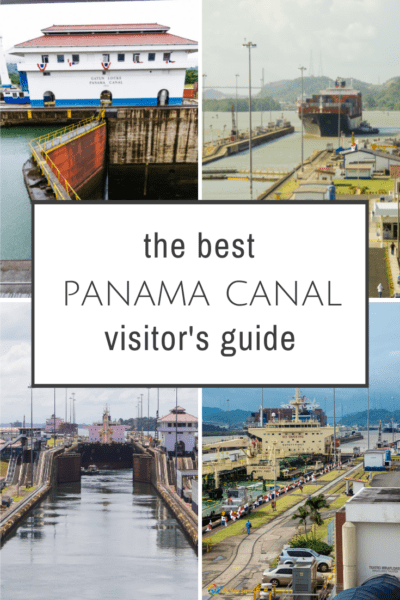
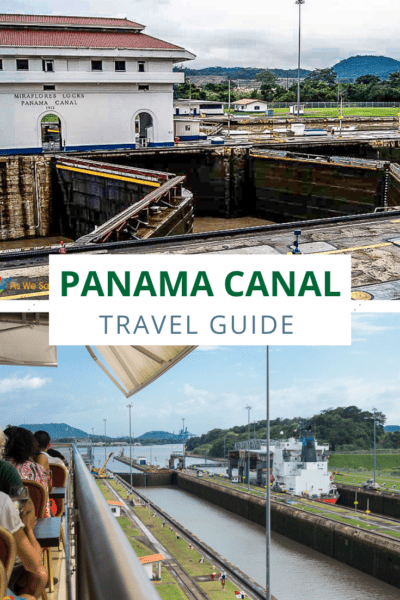
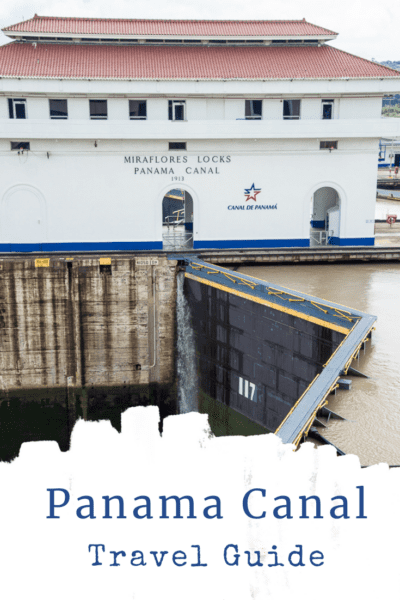
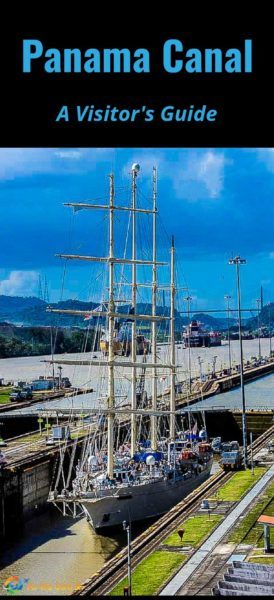
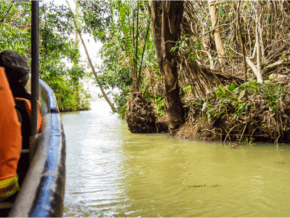
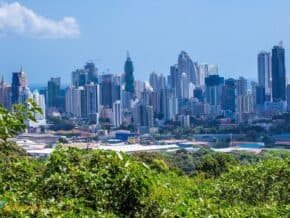
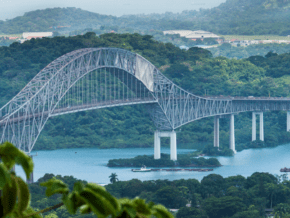
This is a wonderful, informative post. The best I’ve read about visiting the canal without a cruise. It’s been years since you wrote this and I wonder if you know the answers to some questions I’m having trouble researching. I saw the Miraflores Locks and Expansion Visitor Center a few months before the new locks opened. (I asked the taxi driver to take me to the Gatun Locks and canal bridge but he said it was impossible.) Now I have another 24-hour layover, this time with my husband. It’s his first visit and I’m trying to plan to see the things I missed last time.
You mention the Expansion Visitor Center to see the Cocoli Locks. Did you mean the Agua Clara Locks? Is there an established place to view the Cocoli Locks?
I think the Gatun Locks Visitor Center is closed – but can you still see the locks there? Is it worth visiting?
The visitcanaldepanama site says ships don’t transit at Miraflores from 11:40-4:40 and at Agua Clara from 8am – 3:15pm. This seems incomprehensible to me because it overlaps the expansion visitor center hours??? Yet many online reviews say they saw ships in the Agua Clara Locks? Any idea which hours lack transits at Agua Clara?
Finally, I can’t seem to find any recent hours that the canal bridge is open. Do you know where I can find this information? I would love to see the Gatun Locks from that perspective. It’s my #1 priority.
Sorry to pose so many questions. I appreciate any knowledge you have. I’ll be sure to report back and share whatever I discover.
Thanks again for the excellent post.
Hi Miriam, We’re glad you found this post helpful; we updated it once and it looks like we need to do some more research about the expansion. Sadly, we no longer live in Panama so it will take some time to find reliable answers.
To be honest, we can’t imagine why your driver said it was “impossible” to visit Gatun, unless it was too late in the day or he just didn’t want to make the one-hour drive. And the Canal Bridge is near Panama City – you can see it from Casco Viejo – so that makes no sense, either.
The Gatun Locks are still open; that’s where you get the tickets for Agua Clara.
I’ve edited the article to include more information about the expansion, all of which opened after we left the country. The Cocoli Locks are the new locks at Pedro Miguel (I had bad info before) and they are not set up for visitors, so you can forget that one. 🙂
As to ship transit time, I’ve been unable to find the answer, but I’ll keep looking.
And as far as I know there are still only 2 bridges over the canal, Bridge of the Americas and Centennial Bridge, both of which are open. (Though Centennial was damaged a few years ago and it took a while to repair. That’s fixed.) There’s another bridge from Colon to Costa Abajo de Colon but it’s not finished. Here’s the link I found.
When will you be traveling? We’d love to hear more about your adventure!
Best,
Linda
Great detailed post! It really helped in planning our visit to the canal during our time in Panama.
We did, however, discover an additional method to get to the Miraflores locks. There is a MetroBus route that goes directly to Miraflores from Albrook Station. At just 25¢ each way, this was a really easy and cheap way for us to visit.
Really appreciate the tip, Claire. Many of our readers rely on public transportation and this could make all the difference to getting to Miraflores. I’ll add it to our article. Thank you.
Thank you so much for a great and informative article. I’ve always wanted to go to Panama but I especially, especially want to take my mother. She’s always been enthralled with locks and Panama. My dream is to make her dream come through. I had a stroke when I was 22 (a hospital screwup) and her and my father were amazing. I wouldn’t be where I’m at today without their love and support. My father sadly passed but I so want to fulfill this dream of my mother’s.
Is Panama fairly wheelchair friendly? My mother is also in her 80’s so she doesn’t get around too well either. We’d want to see everything!! Is it a reasonably priced area or a very touristy and so expensive?
I have no idea if I’ll hear back from you or even how but to have the option of talking with someone who truly knows and isn’t out for money, oh my. What a relief and please know how very, very grateful I am.
I have umpteen more questions but I guess I’ll leave it at that. Going has always been in the back of my mind and knowing I could never afford it, I let it go. But something brought this to mind and it seems important to do it sooner than later. Scary to have that thought, but it is there.
Sorry, I digress.
Thank you again Linda!!
I hope you are well and enjoyed the holidays.
Hi Valerie! I’m thrilled that we’ve been able to help you. First off, let me tell you how impressed I was to see what you’re doing for your mom. It sounds like she’s an amazing woman.
It sounds like you both are mobility-challenged, is that right? Are you confined to a wheelchair or can you negotiate onto toilets and so forth? Panama is not very wheelchair friendly, partly because it’s relatively new to tourism. That said, Dan and I think it can be done. The higher end hotels in the city have handicapped access rooms as do some of the better resorts along the Pacific. Miraflores Locks has elevators and if I recall it is possible to get up to the front door without having to navigate stairs. I’d say that Amador Causeway is fairly easy (sidewalk ramps). Casco Viejo is probably doable; they were redoing the pavement when we lived there and I don’t remember if the sidewalks have ramps. I think so, though.
Do you want to travel on your own or take a tour? On your own, the biggest issue is getting from place to place. It might be possible to find a vehicle that will accommodate wheelchairs, or to find a tour operator who can help. For a tour guide, we recommend Ancon Expeditions – they offer tours in Panama. We used them when we visited the Darien Gap (which I would not recommend if you can’t climb in or out of boats) and had a great time. Maybe you could call them and ask if they can accommodate you. Their number is 1-888-760-3426.
Due to the influx of affluent Venezuelans in the past few years, prices in the city are higher than in most of Central America. They aren’t as high as the U.S. or Caribbean, though. Local food is basic and is flavorful but not spicy. They sure love their chicken and rice.
Have you seen Curb Free with Cory Lee? Cory hasn’t been to Panama but you might enjoy reading a travel blog by someone in a wheelchair. Happy to help!
I would never pretend that I have all the answers, though. Not sure if you saw it, but Executive Travelers had a little blurb about wheelchairs in Panama. You might also want to ask about Panama for wheelchair-bound travelers on Quora and in TripAdvisor’s Panama Forum, because the large communities guarantee you’ll get the answers you need.
I hope you do make it to Panama; your mom deserves it. Let me know if you have any other questions.
Best wishes,
Linda
If I can only visit one canal museum – which one do you recommend: Miraflores Visitor Center (I am having dinner at the restaurant so won’t need access to the viewing platform) or the Museo del Canal in Casco Viejo??
Thanks!
In our opinion, Miraflores is far more interesting. The one in Casco Viejo is small and its exhibits are limited.
Hi Linda:
If I wanted to go from Panama City to see the Gatun Locks and then drive on to Fort San Lorenzo and back to Panama City at the end of the day, would you still suggest taking a taxi for each leg of the journey?
Thanks, John
Hi John,
Finding an available taxi at Gatun and/or San Lorenzo might be difficult. I think you’d be better off hiring a driver for the day and paying him by the hour. We did that before we bought a car and paid $10/hour back then. A lot of taxi drivers are happy to offer their services or your hotel concierge might have a recommendation.
Alternatively, you can rent a car for the day or book a tour similar to this one. Your idea sounds great – hope you have a good time!
Best, Linda
i was planning a visit to central America and would cross from Costa Rica to David ,Panama.Then when i looked at a map, i saw a thin strip of water cutting through Panama.On closer inspection, it seemed to be the Panama canal.Then i saw this article.Now i have to visit Panama city and the canal.And to think that I almost ended my trip in David then return to Costa Rica would have been a lost opportunity.Seems like a fun place to visit thanks to this article
It is fun. As long as you’re there, you might want to take a boat trip out onto the Panama Canal yourself. We had a great time on that tour.
Hi Linda,
Your article is very informative. I am wife of seafarer and I would like to know that is there any rule or policy which states that no visitor should be on commercial (bulk carriers/ container carrier) ships while passing through panama canal. If any visitor found, authority charges heavy fine to shipping company. My husband and I, we both do not have any idea about this fact. However, we both tried to find out on internet about the same, but we have not found any relevant information. Can you please help me out if you know anything related to this information?
Thanks
We’ve never heard of anything like that. I would be inclined to believe that if any such fines exist they would apply to paying passengers rather than a spouse accompanying a crew member.
That said, we’re not authorities on Canal rules. I’d suggest that you contact the Canal Authority’s Operations Information Office directly (https://www.pancanal.com/eng/contact/operations/ to ensure you’re obeying the rules. If there’s a fine they might offer a workaround solution, such as you could pay a small fee beforehand.
If you are still a bit nervous, you might also want to keep a printout of their response during your journey to ensure your peace of mind.
Thanks so much. We are going in January for a transit with UnCruise Adventures. So excited. This is an awesome primer for our voyage. Cheers and happy travels!
— JR
We hope you have a great time. Please let us know if anything has changed.
My in-laws are planning a trip to Panama (and we’re tagging along!) and transiting the canal is #1 on my mother-in-law’s wish list. I’m glad I remembered you guys have so much info on Panama! The canal sounds so interesting. Time to start planning!
I hope you find some useful articles on our website, Ali. We try to be helpful so please let us know if there’s something special that we’ve missed. And please share your thoughts when you return. I hope you end up liking Panama as much as we do. Have a great time!
This is so informative. I’ve considered going on a cruise through the Panama Canal, but it somehow never occurred to me to experience it as an observer on the land. You’ve enlightened me. That’s so cool that you can drive through the canal, although perhaps a bit nerve wracking.
You are so right, Michele. You have to exercise your faith to cross a rickety steel mesh bridge, knowing there’s a wall of water on one side and seeing a close-up view of the Caribbean (along with a big ship) on the other.
you make this far more interesting than I ever thought something as functional as a canal could be. It must be interesting to be on one of the cruise ships that go through. Your photo of your car on the canal is fantastic! thanks for joining #wkendtravelinspiration
After watching the cruise ships pass through the Canal, we think it would be great to see the canal as a passenger too.
The ship captains must have steady hands when passing through this canal. I’d probably hold my breathe until we’ve passed it. Lol.
Lol. Noemi, it would be hard to hold your breath for that long. It takes 8 to 10 hours for a ship to pass through the Panama Canal.
Linda, I have had the opportunity to visit both sets of locks and see the Pedro Miguel locks from afar. I loved the experienced. The most complicated part of passing through the canal is the locks. They are a bit more than 100 feet wide. When a Panamax ship enter the locks, I think there is only half a meter left on each side. That is why a captain with expertise on that maneuver is needed. I watched a Panamax ship crossing and it was impressive. I would love to go back and see the finished expansion.
If I were a captain I would be thrilled to let a pilot take over taking the ship through the canal. I’ve been through locks in Europe and our cruise ship only fit by a few inches. Navigating is such a skill. So much more so with those bigger locks. I’m with you on seeing the finished expansion. Wouldn’t that be something!?
I didn’t realise they were expanding the Panama Canal. I think would be such a cool thing to experience and the museum really interesting – I love all the history of engineering feats.
We are looking forward to returning to Panama someday to see the new locks. The first ship passed through on June 26, 2016.
The canal is quite fascinating, Linda. I found your post very interesting and quite enlightening. This narrow water passage between the Atlantic and Pacific Oceans always fascinated me. I would definitely like to go see it person. That picture that you took wile crossing it is not only beautiful, but it gave me a different perspective of the canal. Before I’ve got to the part where you explain how the ships travel through the Panama Canal, I was asking myself how in the world can these huge vessels travel through such a narrow space. It makes sense that the captains yield control of the ship while it’s transiting the canal.
I think having those special pilots is probably the smartest thing
I think that having those special pilots is the smartest thing that the canal authority could do. Can you imagine how horrible it would be for shipping if a ship ran aground in that narrow area? The canal would have to shut down for weeks.
Wonderful guide, and interesting to see it from the other side. We sailed through it in April.
We’ve had a chance to boat on the canal and swim in it, but never sailed through the locks (not yet, anyway 🙂 ). Did you have a chance to visit Panama City too?
That’s a great guide to a fascinating place!
Thanks Dave. Have you been?
This is definitely on my bucket list!
I’ve never visited Panama before, but your guide to the Canal looks amazing! I’ll save it for when I go there 🙂
Thanks. I tried to make it a keeper.
Wow! This is a Bucket List experience we have yet to make. Such a comprehensive post with all sorts of aspects I never imagined. Loved the idea of driving across! Must seem surreal. We’ve wanted to see the Canal ever since we read David McCullough’s book. Thanks for putting it back on the radar.
I hope you can, Betsy. It’s not overrated.
Panama Canal is somewhere I definitely want to visit someday. This guide will come in very useful when that time comes! 🙂
Cory, you can do it; there’s an elevator at Miraflores as well as a ramp to get in. I really hope you decide to go because it’s one of those things you’ll always treasure.
We have been to Panama twice and visited the Panama Canal and I must say this is really a definitive Guide to Visiting the Panama Canal. Great job guys.
Thanks. Did you make it to the Caribbean side?
Great guide! We hit the Panama Canal last year and loved it – it was fun actually viewing it from above after we had hiked to the top of Ancon Hill – had brilliant views over the canal and watching the boats come through
Glad you made it to Ancon Hill, Meg. It offers the best views in the city.
I loved visiting the Panama Canal! We went to the Miraflores locks, I found the museum to be especially interesting. Never knew you could drive across the canal though, that would be so cool!
It really is cool. I just wish they would let us stop for a photo or two halfway across, but that’s a no-no. Must. Keep. Moving.
I remember once a school teacher that told us about visiting the Panama canal. I still remember how thrilled I was from the story. I would love to visit one day
I hope you can, Chrysoula. It’s worth the trip.
This is fantastic, I have always wondered how things worked there.
I’m glad you enjoyed it.
This is awesome, Linda! I lived in Panama City for four years when I was younger, and Panama is by far one of my favorite countries to visit. My apartment looked right over the Panama Canal – Something about it is so romantic to me… the merging or the Pacific and Atlantic oceans… the way it looks from up high… the way it looks from the inside of a boat as you’re passing through it. I love this, and I think a ton of people will get so much value from this information. Thanks for sharing.
That’s so kind of you to say, Neysha. Have you been back? You’d be shocked at how much Panama has changed in the last few years. It’s certainly growing quickly and there’s a ton of money being infused into the country from multinational corporations.